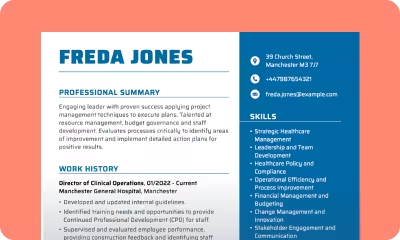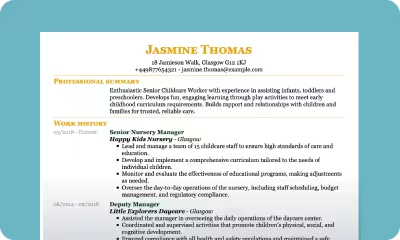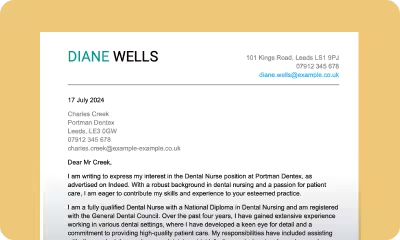- Our customers have been hired by : *Foot Note
Whether you’re just entering the job market or are a seasoned professional, writing a good CV might be a difficult task. Did you know that CVs have a clearly defined structure, which can vary depending on the country in which you are looking for a job? Currently, there are 5 basic CV formats that you can find in the UK. These are:
- one page CV
- two page CV
- skills-based CV
- chronological CV
- and European CV.
Here we will focus on the chronological CV format. The chronological CV format, laid out on a one page CV, is currently one of the most common forms of CV in the UK. The format owes its name to the chronological – or rather reverse chronological – order of the information provided in the CV. In practice, this means that when writing out your employment or education history, you will start with those most recent and work backwards. Although it may seem simple, the process of writing a CV can be a tedious and time-consuming job. Fortunately, we will show you how to make this task much easier. You will learn the structure of the chronological CV format and see practical examples of chronological CVs for different professions. In addition, we will answer the most frequently asked questions, share some valuable tips on writing a chronological CV and point out the most common mistakes to avoid.
SEARCH ALL CV EXAMPLES
What is the structure of the Chronological CV Format
The chronological format of CVs in the UK has a clearly defined structure. Typically, it should fit on one page. Unless you are applying for a job where appearance is important, such as modelling or acting, your CV shouldn’t include a photograph. The structure of the chronological CV includes the following sections:
Contact information
[the first on the CV should be your name and contact details. Place this information at the top of the page. It is common practice to use a fairly large font to make it easy to read. Remember to include the following:]
- First and last name.
- Address, or at least your city and postcode
- Email address
- Telephone number
Personal statement
[ about 3 or 4 sentences will be enough here. Briefly outline who you are, what your achievements are and how you achieved them, or present your goals and how you intend to meet them. Personal statement, serving as a brief summary, should quickly introduce the recruiter to your CV and encourage further reading.]
Work experience
[this section contains details of your employment, ideally from the last ten years or the last three positions. Consider adding a simple overview of the duties you performed on each job. List the jobs in reverse chronological order, starting with the most recent.]
Skills
[following your employment history, also known as the experience section, you should list your job-related skills. Usually, 6-8 skills, listed in bullet points, are all you need. Choose skills from both soft and hard skills categories. Hard skills are those that are necessary to perform the job. A list of these will certainly be included in the job advertisement. Soft skills are transferable skills that enhance your qualifications and help you stand out from other candidates.]
Education
[last, but not least, is the section on your education. Like with experience, start with the most recent. You don’t have to give a comprehensive list and go all the way back to kindergarten, just state the highest education you have.]
AIDEN LEONARD
07912345678
aiden.leonard@example-example.co.uk
11 Guild Street, London, ENG N19 0NB
PROFESSIONAL SUMMARY
Hardworking Makeup Artist with over a decade of experience and proven success at using product knowledge and exceptional customer service skills to provide a tailored service, increase client retention, and exceed sales goals.
WORK HISTORY
06/2019 – Current
Colour and Create Salon, London, Greater London
Senior Makeup Artist
- Developed individual makeup and skin-care programs and recommended products to achieve this at home
- Maintained a solid knowledge base of all salon products and services
- Inventoried, ordered, and stocked makeup product lines.
12/2015 – 05/2019
C’est Magnifique Makeup Counter Westminster, Greater London
Junior Makeup Artist
- Welcomed clients as they arrived for appointments
- Informed clients of appropriate products available to increase retail sales
- Assisted manager with daily salon operations, including opening and closing procedures
SKILLS
Subtle and effective sales skills
Customer service-orientated
Strong verbal communication
Attention to detail
Safety and sanitation training
Excellent phone etiquette
Team player
Airbrush makeup artistry
EDUCATION
2013
London College of Fashion, London
Bachelor of Arts: Hair and Makeup for Fashion
2010
St Mary’s School, London
A Levels: Business Studies, History of Art, English Literature
Chronological CV Format in different samples
Now that you have familiarised yourself with the structure of the CV and seen the practical content that should be included in your chronological CV, it is time to take a look at the different samples. You can easily create your own chronological CV in our CV builder and customise it to your individual preferences in just a few clicks. Notice how a chronological CV with exactly the same content can vary depending on the style you choose.
Sample 1: Acclaimed Chronological CV format
This chronological CV layout looks classic but with a modern twist. The subtle use of colour will make you stand out and attract attention. Choose the colour that best suits your application, from muted steel greys to juicy orange. This chronological CV template is very versatile, great for jobs in the entertainment sector as well as working in a heavyweight corporation.
Sample 2: Impactful Chronological CV format
The CV layout with side column is one of the most classic chronological CV layouts. It is ideal for people who have a lot of experience. The clever use of the column allows you to use space wisely without overloading your CV. Suitable for all sectors, it will work well for experienced professionals.
Sample 3: Centred Chronological CV format
This subdued CV template is a classic approach to a chronological CV. It is elegant and simple. Separating your skills into two columns is a great way to save space and a perfect opportunity to split your hard and soft skills and better present your profile.
When to use a chronological CV
The chronological CV format is so popular that recruiters not only expect it but actually consider it the default form. Chronological CVs can be used practically with any job application. They work well for people who have extensive experience and expertise, as well as for the entry level candidates. This kind of CV format is suitable for all kinds of industries. Whether you’re a lawyer, barber or librarian, this CV format is for your. Chronological CV format allows the job seekers to demonstrate their progression in previous positions and display their career development history. The focus is on the experience that employers are looking for and that is described in the job advertisement. A chronological CV is the most common form of CV – it shows work experience and education in reverse chronological order (most recent to oldest). Unlike a skills-based CV, which focuses on hard skills, in particular, a chronological CV focuses primarily on employment history.
When you are a seasoned professional
Example of work history section for a seasoned purchasing manager
When you have little work experience
Example of work history section for a person with little job experience
When is it better to choose a different format
A chronological CV is so versatile that you can easily adapt it to your job title and level of experience. That said, it is worth noting that while a chronological CV will work well even if you have little experience, those who have no experience at all should opt for a functional CV i.e. a skills-based CV.
Essentially, a chronological CV focuses on experience. Rather than highlighting these gaps, a skills-based CV allows you to focus on the skills that may be relevant to the role you are applying for.
You can read more about the skills-based CV format here.
Download chronological CV format by job
Check out chronological CV examples from different industries and occupations. Create and download your very own CV in just a few minutes with our CV builder. By tailoring the CV to your industry, you can be sure that it will not only be fully professional but that it will also meet accepted standards, and writing a CV in a chronological format gives a better picture of your career development.
Chronological CV dos and don’ts
DO
DO: keep it organised.
Chronological CV format (or rather reverse chronological) means that both experience and education should be listed from the most recent to the oldest one that is still relevant for the role. Also keep the sections in the following order: contact details and personal statement first, followed by experience, skills and education.
DO: add duties to each job title
Ideally, add 3-5 key duties as bullet points for each position. Provide unique tasks for each position to maximise the potential of your CV. This will better represent you as an asset to the company and increase your chances of being invited for an interview.
DONT
DON’T: go over two pages, unless you write an academic CV.
Ideally, your CV should have one, maximum two pages. If you’re struggling with it, you might want to use a professional CV template to fit it to the right format.
DON’T: lie about your experience
If you feel that you have too little experience to create a good chronological CV, it is better to opt for a skills-based one. Remember that a recruiter or employer can very easily verify all the information included in your CV, so trying to bend the truth is never a good idea and might ruin your chances of getting hired in the future..
Frequently Asked Questions about chronological CV Format
What is chronological CV?
A chronological CV is the type of CV format that focuses on your relevant work experience. It displays your employment history in a reverse chronological format, which means that the most recent is on the top. This kind of CV format highlights your achievements and allows the recruiter to see the path of your progression. You can use this CV to apply for a position in any industry. The chronological CV is usually combined with a one page CV format.
Does a CV have to be in chronological order?
Yes, currently this is standard practice. However, it is worth mentioning that when we say chronological order, in the case of CVs we actually mean reverse chronological, i.e. you provide information about your employment starting with the most recent and going back to previous positions. This order enables to follow your career path and your development and also allows the recruiter to get a quick overview of your situation.
How to write a chronological CV?
Start with a good CV template to make things easier. When writing your CV, you should include five basic elements:
- Contact information (name address, phone number and email address)
- Personal statement (3-4 sentences telling who you are, as well as what your professional achievements are and you did to achieve them)
- Work history (in reverse chronological order. For each position, give date of employment (month and year), place of employment and 3-5 key responsibilities)
- Skills (give examples of both hard and soft skills)
- Education (also in reverse chronological order).
Chronological CV: key takeaways
A chronological CV format is the most common and expected by recruiters form of a CV. Its main purpose is to focus on your experience and career path, and highlight your accomplishments, while still mentioning the skills. Recruiters like it because it only takes a glance to get an idea of a candidate’s professional situation.
A well-written chronological CV should fit on one page and contain five basic elements:
- Contact information
- Personal statement
- Work history
- Skills
- Education.
A chronological CV owes its name to the order in which it lists your professional history and education. Namely, you start with your most recent experience at the top of the list and follow it up with your previous experiences. For this reason, you may also come across the name reverse chronological CV.
When writing a chronological CV, it is a good idea to use ready-made CV templates that will allow you to format and arrange all the information correctly, creating a professional document that will impress recruiters. What to remember about the chronological CV format – key takeaway
Build your perfect chronological CV format in 3 easy steps
- Choose a professionally designer CV format
- Add expertly written, tried-and-tested phrases
- Download your CV and apply!
*The names and logos of the companies referred to above are all trademarks of their respective holders. Unless specifically stated otherwise, such references are not intended to imply any affiliation or association with myperfectCV.



